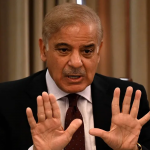The latest data release from the State Bank of Pakistan (SBP) shows that Pakistan’s debt-to-GDP ratio has fallen from 91.2% at the end of 2022-23 (FY23) to 80.1% at the end of 2023-24 (FY24)[1]. On the face of it, these numbers indicate good economic management by the military-backed government. But something doesn’t add up.
Pakistan’s absolute debt from 2022-23 to 2023-24 increased from Pakistani rupees (PKR) 76.5 trillion ($274.4 billion) to PKR84.9 trillion ($304.5 billion) — an 11% increase. However, the debt-to-GDP ratio fell. This could only be possible if Pakistan’s GDP had risen by a massive 25% in local currency. The performance is even more impressive as the Pakistani rupee apparently appreciated by 3% against the U.S. dollar during the 2023-24 financial year. That would mean that in U.S. dollar terms, Pakistan’s economy grew 30% — almost. This mind-boggling accomplishment puts to shame even the world’s fastest-growing large economy, India, which is projected to grow at 7% during 2024-25 (FY25).
What magic is in the making?
Pakistan’s nominal GDP, in local currency, has expanded due to inflation. On key economic criteria, the economy is stagnant. For instance, electricity consumption in Pakistan declined during 2023-24, for the second consecutive year[2]. Other metrics paint a dismal picture: total car sales in Pakistan during 2023-24 was just 81,577 — down 15% from the year prior, and barely a third of that for the year before. Declining cement sales, down for 11 months in a row,[3] is also an indication of the slowdown. A number of multinationals including Shell, Telenor and Total have announced exits from the Pakistani market in the past year. All these indicators point to an economy that is stagnant at best, if not declining.
Inflation in Pakistan averaged 23.4% over 2023-24[4] – meaning, the prices of goods and services rose by that much on an average. Thus, more money changed hands for the same economic activity, creating the illusion of growth. This increase in nominal transaction value does not reflect real economic growth, as the underlying value of goods and services has not increased. The Pakistani rupee should have depreciated against the U.S. dollar and other hard currencies by over 20%, due to the higher inflation in Pakistan. Instead, the PKR went up against the greenback.
This is where Pakistan’s ‘managed float’ comes in. The PKR is officially a freely floating currency, but in reality, the government keeps it artificially strong by restricting foreign exchange outgo by reducing imports.[5] Pakistan imported goods worth $69.9 billion in 2021-22, which has since fallen to $53 billion in 2023-24. A sharp fall in imports signifies a shrinking economy. Pakistan owes dues of $399 million to foreign airlines, the highest in the world (Bangladesh is the other big debtor)[6]. If the Pakistani rupee was to be ‘truly’ floated, it would trade at a much lower level than its current, managed level.
Letting the currency float freely, reflecting its true value, would create two problems: higher prices of imported goods such as oil, fertilizer and food, and higher debt-to-GDP ratio. Pakistan has seen multiple increases in electricity prices over the past year, which has caused public dissatisfaction and led to mass demonstrations in different parts of Pakistan including Islamabad, Rawalpindi and Pakistan-occupied Kashmir (PoK)[7]. The artificially strong rupee made it possible for the government to announce a cut in petrol[8] prices and a subsidy for power consumers in Punjab[9] recently. An exchange rate reflecting the true value of the PKR will make such sops impossible.
The manipulation of exchange rates has enabled the government to bring down inflation. However, this has also caused economic stagnation – Pakistan’s GDP in 2024 is the same as it was in 2017 – meaning the economy has not grown at all in seven years. Pakistan’s current economic crisis has multiple contributors and has resulted from decades of bad decisions. There are no easy ways out, and the pain will persist for some time.
Amit Bhandari is Senior Fellow for Energy, Investment and Connectivity, Gateway House.
This article was exclusively written for Gateway House: Indian Council on Global Relations. You can read more exclusive content here.
For permission to republish, please contact outreach@gatewayhouse.in.
Support our work here.
©Copyright 2024 Gateway House: Indian Council on Global Relations. All rights reserved. Any unauthorised copying or reproduction is strictly prohibited.
References
[1] State Bank of Pakistan. “Pakistan’s Debt and Liabilities Profile”, Pakistan’s Debt Profile, 15 August 2024, https://www.sbp.org.pk/ecodata/profile.pdf
[2] Mettis Global. “Electricity generation drops for second consecutive year”, 22 July 2024, https://mettisglobal.news/electricity-generation-drops-for-second-consecutive-year/
[3] Mettis Global. “Cement dispatches drop 6.81% in July 2024″, 5 August 2024, https://mettisglobal.news/cement-dispatches-drop-6-81-in-july-2024/
[4] State Bank of Pakistan “Inflation Monitor” June 2024 https://www.sbp.org.pk/publications/Inflation_Monitor/2024/Jun/IM_June_2024.pdf
[5] Iqbal, Shahid. “IMF’s liberal import plan may imperil stable rupee”, Dawn, https://www.dawn.com/news/1814540/imfs-liberal-import-plan-may-imperil-stable-rupee
[6] International Air Transport Association (IATA). “Pakistan and Bangladesh Blocking Over $720m of Airline Revenues” 24 April 2024, https://www.iata.org/en/pressroom/2024-releases/2024-04-24-01/
[7] Yasin, Aamir. “Rawalpindi traders warn of countrywide protests if electricity slab system not withdrawn”, 2 July 2024, Dawn, https://www.dawn.com/news/1843234
Naqash, Tariq. “Police crackdown in AJK prompts ‘shutter-down strike’ call”, 10 May 2024, Dawn, https://www.dawn.com/news/1832587/police-crackdown-in-ajk-prompts-shutter-down-strike-call
[8] Ali, Sajjad. “Big Drop in Fuel Prices in Pakistan: Check Latest Rates Here”, Khyber News, 31 July 2024, https://khybernews.tv/big-drop-in-fuel-prices-in-pakistan-check-latest-rates-here/
[9] Tahir, Zulqernain. “Punjab cuts power tariff by Rs14 for up to 500 units”, Dawn, 17 August 2024, https://www.dawn.com/news/1852806/punjab-cuts-power-tariff-by-rs14-for-up-to-500-units


